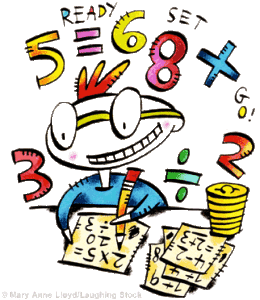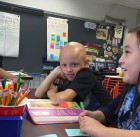Viewing: October, 2015
October 14, 2015
Reviewing Math Skills
 In late September, students completed the first math assessment. Normally, we strive to score these and promptly send them home for you to review, sign, and return to us. This time, however, we have intentionally held off on doing so. We found that there were several items on the assessment that were challenging to students, and we wanted to review many of these with the class. For the past few weeks, we’ve been reviewing skills with the whole class that were challenging for a large group of students. Mr. Walmer and I have also been pulling students to address skills that are best taught by repeated practice in small groups, such as rounding, multi-digit subtraction with regrouping, and standard form/word form/expanded form. As you receive and review the assessments, please rest assured that we are working with your fourth grader on any areas that he or she struggled with.
In late September, students completed the first math assessment. Normally, we strive to score these and promptly send them home for you to review, sign, and return to us. This time, however, we have intentionally held off on doing so. We found that there were several items on the assessment that were challenging to students, and we wanted to review many of these with the class. For the past few weeks, we’ve been reviewing skills with the whole class that were challenging for a large group of students. Mr. Walmer and I have also been pulling students to address skills that are best taught by repeated practice in small groups, such as rounding, multi-digit subtraction with regrouping, and standard form/word form/expanded form. As you receive and review the assessments, please rest assured that we are working with your fourth grader on any areas that he or she struggled with.
The final question on the assessment was a particularly challenging problem, in part, because it was not written in the most clear way. Many students lost points on this one question, and because it accounted for 9 points on the 36 point assessment. So you can see how struggling on this one question could dramatically impact students’ individual scores. For that reason, we strongly encourage you to look at your son or daughter’s performance on individual questions, rather than focusing on the percentage score (which, in all candor, tended to be lackluster for students throughout the class). Additionally, Mr. Walmer taught a great lesson yesterday that reviewed that challenging final question. After practicing the skill in class, students completed a similar problem, and we are so pleased that ALL students improved on their score from the assessment. Those reteaching worksheets are stapled to the end of the students’ assessments.
We ask that you take time this week to review your child’s performance on the math assessment, sign it, and PLEASE SEND IT BACK TO SCHOOL. Once again, we encourage you to examine how your child did on individual problem-sets (in rows, with the row score on the left side of the page) in order to look for strengths and weaknesses. Please don’t dwell on the percentage score, which was (for many students) pulled down by one challenging question at the end of the assessment.
Posted in Class Updates|By Jon Moss
October 4, 2015

Learning to Collaborate
A big focus in Room 209 in learning to collaborate on tasks and explain your thinking. People often think that collaboration helps during challenging activities, and that’s certainly true. But we also have students collaborate even when they could easily complete a task independently, because the process of sharing ideas, considering other points of view, and discussing strategies and options helps students to think more deeply about a given topic. It also helps to develop collaboration skills that are, of course, critical life skills.
Last week, for example, we began working on narrative elements by focusing on the setting of stories. We read, as a class, The Purple Coat (one of my all-time favorites) and identified clues about the setting. I then modeled the process of writing a short-answer response (SAR) to identify and explain the setting of the story. We looked at the SAR Checklist as a way of remembering the elements of a successful short-answer response. Students then collaborated with one or two partners to write a similar response about The Josefina Story Quilt, which students read for homework on Monday or Tuesday. We shared some of these responses (from groups that volunteered) and discussed strengths and weaknesses, using the new fourth grade SAR rubric. (Stay tuned for some resources for parents!) On Friday, students worked independently to write their own SAR about the setting of A Chair for My Mother (which is arguably my all-time favorite children’s book). This process of gradual release supports students as we move from teacher-led learning to group work to independent application. You’ll see a lot of this style of learning this year, especially in the next few weeks as we address the remaining narrative elements.
Posted in Class Updates|By Jon Moss
